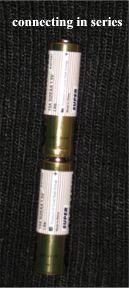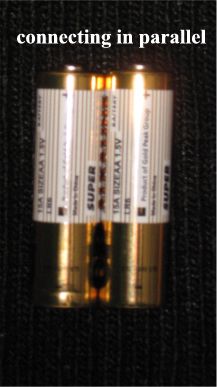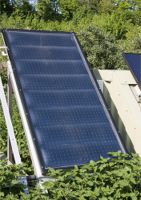|
What are
|
 | Stretch your imagination and view in your mind a cascade of two water falls, the higher one feeds the lower one. The electrical terminology to cascading two “cells” is “connecting in series”. Connecting in series provides higher voltage (e.g. if you connect two AA batteries in series you get 2 times 1.5V = 3V |
 | Now, imagine two water falls flowing side by side, the amount of water they both flow is the summation of their individual flows. In the electrical terminology it is called “connecting in parallel”. (e.g. if you connect two AA batteries in parallel you can draw twice the current than what a single AA will give you) |

The solar electric panel picture is attributed to Dominic's picks (taken from Brighton Earthship Solar Panel).
A Photovoltaic Array (also known as solar panel) is an array of photovoltaic cells connected in series (to get higher voltage) and in parallel (to get higher current).
The solar panel voltage is specified in Volts (DC) and its available current is specified in Amperes
Another specifications you will find is the kWp (Kilowatt Peak), a measure of the nominal power of the solar panel exposed to "standard" laboratory illumination conditions. one Watt is an electrical power unit, the multiplication of 1 Volt and 1 Ampere. One Kilowatt is 1000 Watts.
The Peak stands for what the panel will produce in noon time of a sunny day. Since the sun doesn't shine in night and since its angle is not optimal early and late in the day, the total energy the panel produces in 24 hours is not 24 times the KWHP rating. It is more like 6 times the KWHP rating and it depends on the season and the location.
The solar Electric Panel Video
I invite you to watch a short video on the assembly of a solar panel
Thin Film Solar Panels
The video shows legacy solar panels, there is a new emerging technology of thin film solar panels. Click to see what are the Thin film solar panels everyone is talking about
Size, Power and efficiency
Same size solar panels won't produce the same electric power even if they are exposed to the sun. Differences in technology cause different efficiency, so the amount of power in Watts produce per square feet (or per square meter) is different for different panels. In most cases, an homeowner can allow for bigger size panels and really interesting comparison would be the price of the solar panels in terms of $ per Watt, a number that can go anywhere between $1 to $5.
There are cases though where area is limited, in these cases the more efficient panels, these panels that produce more electrical power for the limited roof size should be chosen
return from solar electric panels page to solar electricity page click to view my Home Page
This site for sale, affordable price
click to contact me for details

click to search the content on this site







